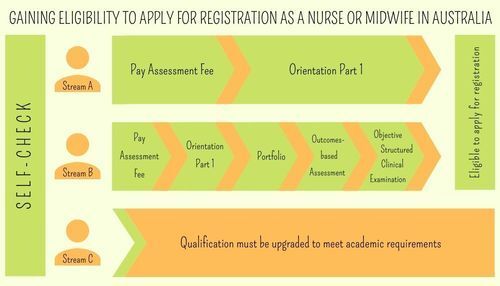How To Register as a Nurse or Midwife in Australia
If you want to work as a nurse or midwife in Australia, you will have to embark upon a sophisticated assessment, application and registration journey. Read an overview of the process.
The Process of Becoming a Registered Nurse or Midwife in Australia
The process has been designed to ensure that nurses in Australia are equipped with the knowledge, skills and understanding to practise safely and competently in a range of healthcare settings. After all, nursing is the most trusted profession in Australia, a deserved reputation and one the Australian Health Practitioner Regulation Agency (AHPRA) is determined to uphold.
Becoming a registered nurse and/or midwife with the
Nursing and Midwifery Board of Australia (NMBA) is a multi-staged procedure that can seem a bit overwhelming at first, but don’t worry, we’ve got you covered! Before we go into detail, here are
five key points and tips about internationally qualified nurses and midwifes (IQNMs) registering with the NMBA:
- Carefully check the NMBA’s required core standards and qualifications. If you do not fulfil the criteria, you may want to decide to look at further training opportunities to improve your qualifications yourself rather than spending time and money on the eligibility check and be told to do so.
- Do not make any irreversible decisions – such as resigning from current employment or moving to Australia – until you have applied for and been approved for registration with the NMBA. The process timeframe depends on the unique circumstances of each application and is therefore uncertain.
- Your journey starts with the NMBA self-check where you enter your qualifications and will be assigned to one of three streams which will determine the further steps and assessments you will need to take. Only after they are all completed will you be eligible to apply for registration.
- To help make the processing of your application run smoothly and avoid unnecessary delays, make sure your application is complete, i.e. you have completed all required assessment stages and all supporting documents are provided. Make sure to request any documentation required from third parties in time.
- Be aware that the process does not end with being awarded registration. You will definitely have to complete the Orientation Part 2 course and local orientation training. If your registration is conditional or In Principal, there will be further tasks to complete.
Prior to embarking on the registration process – Core standards and qualification criteria
Nursing and midwifery standards in Australia are extremely high to ensure top quality service in a range of healthcare settings. While International Qualified Nurses and Midwives (IQNMs) can register to practise in Australua, they have to demonstrate that they meet the core standards and possess qualifications equal to nursing and midwifery training in Australia.
The core standards largely concern background criteria and basic practice experience. With the exception of registered students and non-practising registrants, the requirements apply to both applicants and currently registered nurses and midwifes.
Criminal history:
Candidates must declare their criminal history in all countries, including Australia, for the AHPRA to ensure that only those who are suitable and safe to practise are granted registration. Police Checks will usually be required and should be obtained in plenty of time.
English language skills:
A candidate must demonstrate that their competency in speaking and communicating in English is sufficient to practise nursing and/or midwifery. If English is the applicant’s primary language, this will usually be accepted and a demonstration of five years of continuous education taught and assessed solely in English may suffice as well.
Otherwise, the candidate will have to sit a language proficiency test. Accepted tests and minimum scores are IELTS Academic (7 overall and 7 in each component), PTE Academic (65 overall and 65 in each communicative skill) or TOEFL iBT (94 overall, 24 each for listening and reading, 27 for writing, 23 for speaking) for nursing and/or midwifery or OET (B in each component) for nursing only.
Continuing professional development:
A candidate must evidence the completion of at least 20 hours of CPD per registration period.
Recency of practice:
An applicant must either hold or have held current and valid registration with a recognised nursing or midwifery regulatory authority, or their role must involve the application of nursing and/or midwifery knowledge and skills, or the candidate must have carried out a relevant postgraduate education leading to an award or qualification. Furthermore, a candidate must have completed a minimum of 450 hours of practice within the past five years, or must alternatively have successfully completed a programme or assessment approved by the NMBA or demonstrate a successful completion of a period of supervised practice approved by the NMBA.
Professional indemnity insurance arrangements:
A candidate must hold appropriate professional indemnity insurance which provides security for the nurse/midwife’s professional practice, covers insurance against civil liability incurred by, or loss arising from, a claim that is made as a result of a negligent act, error or omission in the conduct of the nurse/midwife.
Besides fulfilling the required core standards, IQNMs must meet a number of qualification criteria to demonstrate that their training overseas is comparable to that in Australia.
Recognised qualification:
The IQNMs qualification must have been recognised by a statutory registration or licensing body for registration as a registered nurse and/or midwife or enrolled nurse in the country where the qualification was received and the candidate must have met any pre-registration examination requirements.
Quality assurance and accreditation:
The IQNM’s qualification must have been subject to quality insurance and recognised or accredited by a body external to the education institution and based on published accreditation standards. These accreditation standards must include: contemporary approaches to education, institutional resources (staffing and facilities), evidence-based and contemporary nursing/midwifery practice, workplace experience across a variety of healthcare settings, and medication management that addresses safe and effective use of medicines. The published processes for reviewing programmes and providers against the accreditation standard must include: an assessment conducted by an individual or team with appropriate expertise in education and practice as well as information on institutional resources (staffing and facilities).
Qualifications issued by institutions in the following countries are likely to meet this criterion:
Canada (nursing), Hong Kong (nursing), Republic of Ireland (nursing and midwifery), UK (nursing and midwifery), USA (nursing and midwifery). Further, qualifications awarded in Belgium Flanders (nursing and midwifery), Chile (nursing), Hong Kong (midwifery), Pakistan (nursing and midwifery), Papua New Guinea (nursing) and Singapore (nursing and midwifery) may suffice. If an IQNM holds a qualification issued anywhere else, there is a chance they will have to seek further training opportunities.
Academic level of qualification:
The academic level of an IQNM’s qualification must be comparable to, at a minimum, and Australian level 7 Bachelor Degree for registered nurses and/or midwives or an Australian level 5 Diploma for enrolled nurses.
Gaining eligibility to apply for registration
If an IQNM is confident they meet the standards and qualifications and wishes to go ahead with relocating to Australia, they must first complete the AHPRA self-check to gain eligibility to apply to become a registered nurse and/or midwife with NMBA
An IQNM has to complete the self-check themselves, no third party or agent can do it for them. Essentially, the self-check will require the entry of basic identity information and relevant professional qualifications. AHPRA has already previously assessed a wide range of qualifications which will be available to select when completing the self-check. If a qualification does not appear, the candidate will be advised on the further steps to take.
The self-check identifies the assessment stages that must be completed before an IQNM can apply for registration and accordingly assigns each taker to one of three streams. Only after successfully completing all required assessment stages can an IQNM apply for registration and will be assessed against eligibility requirements.
Stream A: IQNMs who hold a qualification considered to be substantially equivalent, or based on similar competencies, to an approved qualification.
Stream A candidates must first pay the assessment fee of AUD $640 in order to proceed. They must then successfully complete Orientation Part 1, an online learning course that can be completed from a candidate’s personal device. This course is an introduction to Australia and the Australian healthcare context, covering topics such as the roles and functions of nurses and midwifes within the Australian healthcare setting.
Stream B: IQNMs who hold a qualification that is relevant to the profession but is not substantially equivalent, nor based on similar competencies to an approved qualification.
Stream B candidates too must first pay the assessment fee and successfully complete Orientation Part 1 in order to proceed. Additionally, they must complete further assessments, starting with a Portfolio which provides qualification and identification details and documentation. The Portfolio must show official documentation for all qualifications relevant to the candidate’s portfolio, which may include a copy of the awarded course certificate or a copy of an academic transcript, evidence of any changes of name and proof of identity. These must all be certified and for documents in any language other than English, translated copies must be provided. The Portfolio stage will be followed by an Outcomes-Based Assessment (OBA) comprising a multiple-choice question exam related to the profession or division in which the candidate intends to register and finally an Objective Structured Clinical Examination (OSCE) related to the respective profession or division.
Stream C: IQNMs who hold a qualification that is not substantially equivalent or relevant to an approved qualification.
For those receiving a Stream C outcome, the only way to proceed is to upgrade their qualification in Australia or any other country of choice. The further training must lead to an award that meets the defined qualification criteria.
The IQNM’s qualification needs further assessment.
If an IQNM’s qualification does not appear on the self-check and needs to be assessed by AHPRA, they can still proceed with the check. Like Stream A candidates, they must first pay the assessment fee and complete Orientation Part 1. Additionally, they must submit a Portfolio like Stream B candidates which must moreover include a copy of the original certificate of registration from the original regulatory authority. The next steps will be advised once the qualification has been assessed. The taker may carry on as an A or B candidate or might be told they need to upgrade their qualification as a Stream C IQNM.

Applying for registration with the NMBA
Once a Stream A or B IQNM candidate has successfully completed the self-check and any required assessment stages, they are eligible to apply for registration - the registration application form will be made available within the IQNM candidate’s dashboard.
The time it takes to assess an application is uncertain; while AHPRA aim to complete the process within four to six weeks of receipt of all required documentation, an assessment can take up to eight to ten weeks depending on the unique circumstances of each application.
The candidate must pay the application and registration fees upon submitting their application. They might be contacted for any additional documentation of information needed in which case they have 30 days to provide what is required.
If the application documentation matches with the information provided during the self-check, the candidate can proceed to next stage. If not, the application will be subject to further assessment and the candidate may either be allowed to proceed as well or will be reimbursed their registration fee and advised on whether to restart the process as a Stream B or C outcome.
Once AHPRA has confirmed a candidate’s identity, they will make a decision on the application which can be one of three possible outcomes:
1: Registration granted or In Principle Registration
If the applicant is already based in Australia and has met all requirements and standards, they will receive an email confirming their registration. If the candidate still lives overseas, they will be posted an In Principal Approval, meaning they are registered pending further documentation. This can include Australia-specific identity documents that could not be provided initially due to the practice location and will certainly request a Certificate of Registration Status or Certificate of Good Standing from every jurisdiction outside of Australia where the IQNM has been registered over the past five years. The candidate is given three months to submit the documentation.
2: Registration with conditions and a notation
A conditional registration may be awarded when an IQNM does not meet the academic qualification criterion, but satisfies all other criteria and standards. This outcome will require the completion of a period of 12 months full-time equivalent supervised practice.
3: Refusal
If AHPRA finds a candidate does not meet the required standards, the candidate will be refused registration and the registration fee will be refunded. If a candidate does not agree with the application outcome, he or she generally has the right to appeal the decision and take the case to a tribunal.
Working in Australia
Once granted registration, with or without conditions, an IQNM should obtain employment and, if not already based in Australia, start the emigration process.
IQNMs must also complete Orientation Part 2 within six months of the initial registration. This is an online learning course giving a more in-depth orientation to the Australian healthcare context. Further, employers of IQNMs are expected to provide a workplace induction and/or local orientation. IQNMs are asked to actively seek this training.
If you are interested to work as a nurse or midwife in Australia, please
register your CV.
Share this post on Social Media
Leave a Comment
SEARCH JOBS
Ready for a change? Whether you’re looking for higher compensation, greater autonomy, a better work-life balance, or just a change in scenery, we have job opportunities in wonderful locations across the world. Start your medical or dental job search today and embark on your next career move.
SIGN UP FOR JOB ALERTS
We believe everyone deserves to find their dream job. Be the first to hear about new practice opportunities in exciting locations across the world Simply sign up for job alerts in your chosen field, and we will email you when a new job in your specialty becomes available.
More Insights












